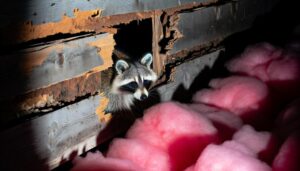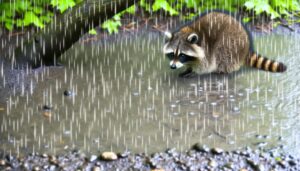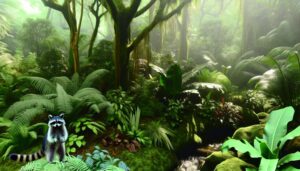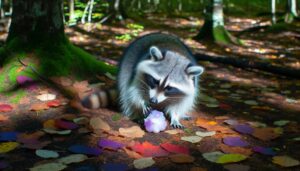How Raccoons Are Suited to Live in Different Habitats
Raccoons are remarkably adapted across diverse habitats through several key adaptations. Their dexterous forepaws and semi-retractable claws enable efficient foraging and manipulation of objects.
They possess acute night vision and an agile body structure for nocturnal activities. Their omnivorous diet includes fruits, nuts, small vertebrates, and human refuse, allowing for immense dietary flexibility.
In urban settings, raccoons exploit anthropogenic resources and demonstrate problem-solving skills in accessing waste. In forests and wetlands, they use tree cavities and dense vegetation for nesting and foraging, utilizing their keen sense of touch.
These traits contribute to their ecological resilience. Discover more intricate details here.
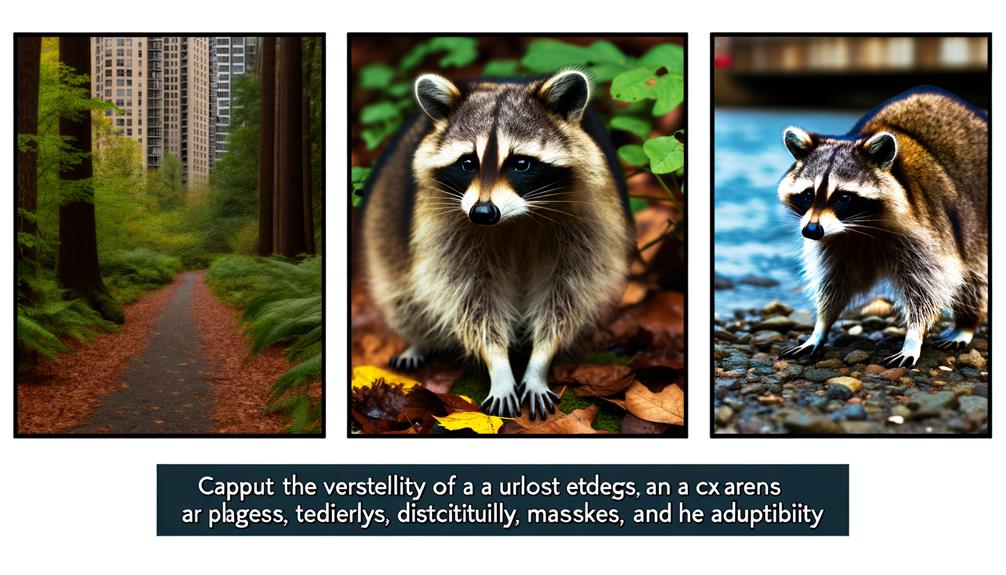
Key Takeaways
- Raccoons' omnivorous diet allows them to thrive in diverse ecosystems by exploiting various food sources.
- Dexterous forepaws and semi-retractable claws enable climbing and handling objects, aiding in both urban and forest environments.
- Nocturnal behavior minimizes human-wildlife conflict and competition for resources with other species.
- Acute spatial memory and problem-solving skills facilitate accessing anthropogenic resources in urban areas.
- Flexible nesting preferences, including tree cavities and man-made structures, provide protection across different habitats.
Physical Adaptations

Raccoons exhibit a range of physical adaptations, including dexterous forepaws and a keen sense of touch, that enable them to thrive in diverse habitats.
Their forepaws possess hyper-sensitive nerve endings, facilitating intricate manipulation of objects and foraging efficiency. This tactile acuity is complemented by their semi-retractable claws, allowing for adept climbing and handling of diverse materials.
Additionally, raccoons have a robust, agile body structure, featuring a flexible spine and strong hind limbs, which aids in maneuvering varied terrains such as urban environments, forests, and wetlands.
Their acute night vision, due to a high rod-to-cone ratio in their retinas, enhances their nocturnal activities. These physical characteristics collectively underpin the raccoon's adaptability to a wide array of ecological niches.
Diet Versatility
Possessing an omnivorous diet, these adaptable mammals exhibit remarkable dietary versatility, consuming a wide array of food sources ranging from fruits and nuts to small vertebrates and human refuse. This dietary flexibility enables raccoons to thrive in various ecosystems, from dense forests to suburban areas.
Their foraging behavior is characterized by opportunism and adaptability, allowing them to exploit seasonal and locally abundant food sources. Evidence from observational studies indicates that raccoons can alter their diet based on availability and environmental conditions.
Key dietary components include:
- Fruits and nuts: Essential for energy during autumn and winter.
- Small vertebrates: Provide critical protein and fats.
- Human refuse: Offers a reliable food source in urban settings.
This broad diet underscores their ecological success and resilience.
Urban Survival Skills

Leveraging their dietary versatility, these adaptable mammals have developed a suite of urban survival skills that enable them to navigate and thrive in human-dominated landscapes. Raccoons (Procyon lotor) exhibit a remarkable ability to exploit anthropogenic resources. They demonstrate advanced problem-solving skills, such as opening containers and accessing waste bins.
Their nocturnal behavior reduces human-wildlife conflicts and enhances foraging efficiency. Observational studies indicate that raccoons possess acute spatial memory, allowing them to remember locations of food sources and safe nesting sites. Moreover, their physical dexterity, characterized by nimble forepaws, facilitates manipulation of complex objects.
These adaptive traits collectively guarantee raccoons' resilience and success in urban environments, underscoring their ecological plasticity and evolutionary adaptability.
Forest Habitats
How do raccoons adapt their foraging strategies and nesting behaviors to the diverse and resource-rich environments of forest habitats?
Raccoons exhibit remarkable adaptability, utilizing their dexterous forepaws to exploit a variety of food sources, including fruits, nuts, insects, and small vertebrates. Their nocturnal habits reduce competition and predation risks.
Raccoons prefer tree cavities as nesting sites, providing shelter and safety for rearing young. This arboreal preference also aids in avoiding terrestrial predators.
Key adaptations evoke awe:
- Dexterous Forepaws: Enable manipulation of varied food items.
- Nocturnal Foraging: Minimizes competition and predator encounters.
- Arboreal Nesting: Offers protection and a strategic vantage point.
These strategies demonstrate the raccoon's evolutionary success in forest ecosystems.
Wetland Living
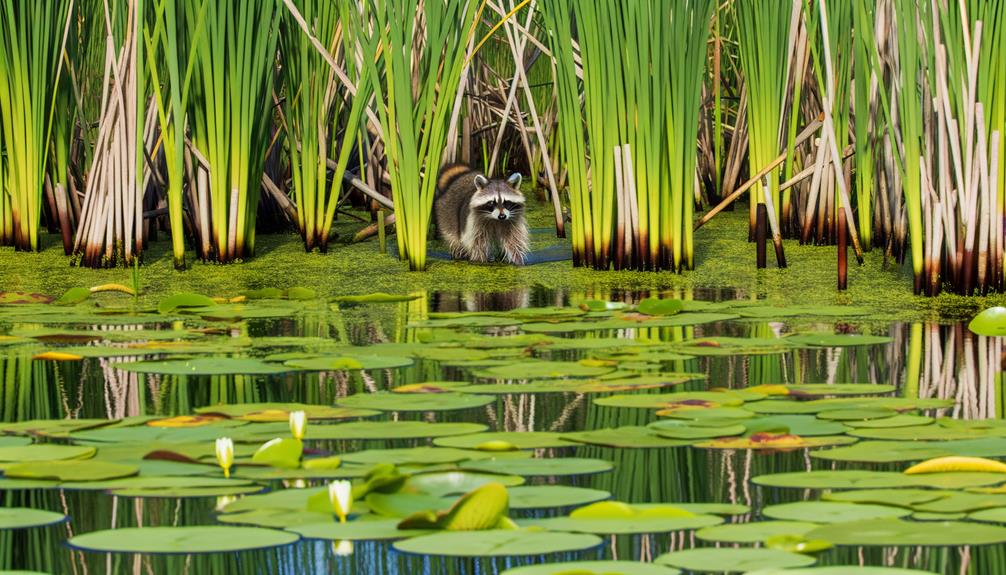
In wetland ecosystems, raccoons exhibit remarkable adaptability in their foraging strategies, utilizing the abundant aquatic and terrestrial resources.
These habitats provide essential shelter and nesting opportunities, often in hollow trees or dense vegetation, which facilitate protection from predators and harsh weather conditions.
Observational studies have documented raccoons' proficiency in capturing a variety of prey, including amphibians, crustaceans, and small fish, illustrating their opportunistic feeding behavior.
Foraging in Wetlands
Raccoons inhabiting wetland ecosystems exhibit distinctive foraging behaviors characterized by their adept use of tactile sensitivity and opportunistic feeding strategies. These behaviors allow them to efficiently exploit the diverse resources available in such habitats.
Detailed observations reveal that raccoons use their highly sensitive forepaws to detect and capture prey under waterlogged conditions, where visibility is limited. Their diet is variably varied and includes:
- Crustaceans – Crabs and crayfish form a significant part of their diet, reflecting their skill in capturing these elusive creatures.
- Amphibians – Frogs and salamanders are commonly preyed upon, demonstrating their ability to navigate marshy terrains.
- Aquatic Plants – Consumption of roots and shoots highlights their adaptability to seasonal food availability.
Such evidence underscores the raccoon's remarkable ecological versatility.
Shelter and Nesting
Exhibiting a high degree of adaptability, raccoons in wetland habitats construct their shelters in a variety of locations, including hollow trees, dense vegetation, and abandoned burrows, to guarantee protection against predators and environmental elements.
These diverse nesting sites are strategically chosen based on availability and safety, as well as proximity to food and water sources. Hollow trees offer elevated, secure refuges, minimizing ground-level threats. Dense vegetation provides camouflage and insulation, maintaining thermal regulation during colder months. Abandoned burrows are opportunistically utilized, reducing energy expenditure in creating new dens.
Studies have shown that raccoons often prefer locations that offer both concealment and easy access to feeding areas, optimizing their survival and reproductive success in the dynamic wetland environment.
Agricultural Areas
In agricultural areas, raccoons exhibit notable adaptations in their diet and food sources, frequently consuming crops such as corn and fruit. These environments also provide various shelter and nesting opportunities, with raccoons often utilizing barns, outbuildings, and dense vegetation.
The interaction with crops can lead to significant agricultural impact, necessitating studies on raccoon behavior and management practices to mitigate crop damage.
Diet and Food Sources
Agricultural areas provide a diverse array of food sources for raccoons, including crops such as corn, fruit, and vegetables, which they opportunistically exploit. These environments offer a consistent and abundant food supply, which raccoons can access due to their intelligence and dexterity.
Empirical studies indicate that raccoons in these regions exhibit a notable dietary shift toward human-grown produce, contributing to their adaptive success.
Here are three striking impacts:
- Crop Damage: Significant economic losses for farmers due to raccoon foraging.
- Nutritional Variety: Enhanced diet diversity for raccoons, promoting robust health.
- Human-Wildlife Conflict: Increased interaction between raccoons and farmers, often leading to conflict.
These factors underscore the complex interplay between raccoons and agricultural ecosystems.
Shelter and Nesting Habits
Raccoons residing in agricultural areas often utilize a variety of structures for shelter and nesting, including barns, abandoned buildings, and dense crop fields, which provide both security and proximity to food sources. These environments offer raccoons ample hiding spots and protection from predators.
Detailed observations indicate that raccoons prefer elevated or enclosed spaces, such as attics and lofts in barns, which safeguard them from environmental stressors and human activities. Additionally, dense vegetation in crop fields serves as effective camouflage, allowing raccoons to evade detection.
Studies reveal that raccoons frequently reuse these nesting sites, demonstrating a high level of site fidelity. This behavioral adaptability underscores their resilience and ability to exploit anthropogenic landscapes for survival.
Interaction With Crops
Farmers frequently report significant crop damage attributed to raccoon activity, highlighting the species' propensity to exploit agricultural resources for sustenance.
Scientifically observed behaviors indicate that raccoons selectively target high-calorie crops, which maximizes their energy intake. This opportunistic feeding can result in substantial economic losses for agricultural producers.
Detailed observations reveal that raccoons possess dexterous forepaws, enabling them to peel back husks and penetrate protective coverings, exacerbating crop vulnerability.
Key impacts include:
- Economic Losses: Farmers face financial strain due to reduced yields and increased costs for raccoon deterrence.
- Crop Contamination: Raccoons can introduce pathogens and contaminants, jeopardizing food safety.
- Ecosystem Imbalance: Over-reliance on crops can disrupt local ecosystems, affecting other species and plant diversity.
Such interactions necessitate effective management strategies to mitigate raccoon-induced damages.
Suburban Life

In suburban environments, *Procyon lotor* exhibits remarkable adaptability, taking advantage of human-provided resources such as garbage bins, pet food, and garden crops. These raccoons display opportunistic foraging behavior, characterized by their ability to exploit anthropogenic food sources efficiently.
Studies have shown that suburban raccoons have higher body weights and reproductive success compared to their rural counterparts, attributed to the consistent availability of calorically dense food. Their cognitive flexibility allows them to navigate complex urban landscapes, opening garbage containers and accessing food in novel ways.
This behavioral plasticity underscores their success in suburban settings, where they often become nocturnal to minimize human interaction, thereby reducing potential threats. This adaptability enhances their survival and reproductive potential in these modified habitats.
Shelter Finding
Leveraging their cognitive flexibility and opportunistic behavior, *Procyon lotor* also exhibits considerable ingenuity in identifying and securing shelters within suburban environments. Their adaptability is evident in the diverse types of shelters they utilize, ranging from natural to man-made structures.
Detailed observations indicate that raccoons prefer secure, elevated locations for nesting, which provide protection from predators and environmental elements. This behavior is supported by evidence such as:
- Tree cavities: Raccoons frequently exploit these natural formations for their elevation and concealment.
- Attics and chimneys: Suburban raccoons often infiltrate human dwellings, utilizing these spaces for warmth and safety.
- Abandoned buildings: These structures offer multiple entry points and ample hiding spots, meeting their shelter needs effectively.
These behaviors underscore their remarkable adaptability to varied habitats.
Seasonal Behaviors

Raccoons exhibit distinct seasonal behaviors that are critical to their survival across various habitats. During winter, they rely on fat reserves and reduced activity to endure scarcity.
Spring prompts increased foraging driven by the availability of diverse food sources.
In summer, raccoons prioritize nesting behaviors, ensuring the protection and development of their offspring.
Winter Survival Tactics
Adaptations for winter survival in raccoons involve a combination of behavioral and physiological strategies to cope with reduced food availability and harsher environmental conditions. Notably, raccoons undergo a period of winter dormancy, where they decrease their metabolic rate to conserve energy.
Additionally, raccoons increase their body fat reserves during autumn, providing essential insulation and energy stores during the colder months. They also exhibit a preference for denning in secure, insulated locations such as hollow trees or abandoned burrows.
Observations indicate the following critical adaptations:
- Metabolic Suppression: Reduced metabolic rate during dormancy conserves energy.
- Fat Accumulation: Increased body fat acts as insulation and an energy reserve.
- Selective Denning: Preference for insulated dens minimizes heat loss.
These strategies collectively enhance raccoon survival through winter's challenges.
Spring Foraging Patterns
During the spring, diverse foraging patterns emerge as raccoons exploit the seasonal abundance of food resources, characterized by increased activity and varied diet.
This period witnesses a shift from their winter diet of stored fat and limited food sources to consuming a wide array of insects, fruits, small mammals, and amphibians.
Studies indicate that raccoons exhibit crepuscular and nocturnal foraging behaviors, maximizing their energy intake during twilight hours.
Observational data highlight their adaptability in different habitats, from urban areas scavenging for human refuse to rural settings hunting for naturally available prey.
This seasonal dietary flexibility underscores their ecological plasticity, allowing raccoons to optimize food acquisition and sustain their metabolic needs in fluctuating environmental conditions.
Summer Nesting Habits
In the summer months, raccoon nesting habits exhibit a marked preference for secure, elevated locations such as tree cavities, attics, and abandoned buildings, which provide protection from predators and harsh environmental conditions. These arboreal and anthropogenic habitats serve as essential sanctuaries, ensuring the survival of both adult raccoons and their offspring. Detailed observations indicate that these locations offer several benefits:
- Safety from Predators: Elevated nests reduce the likelihood of encounters with terrestrial predators.
- Temperature Regulation: Tree cavities and attics maintain a more stable microclimate, protecting raccoons from extreme heat.
- Proximity to Food Sources: These sites are often strategically selected near abundant food supplies, minimizing the travel distance for foraging.
Such adaptive behaviors underscore the raccoon's remarkable ecological versatility.
Human Interaction
Human interaction with raccoons has greatly influenced their behavior, distribution, and survival strategies across various habitats. Urbanization and suburban development have led raccoons to adapt to human-altered environments, utilizing anthropogenic resources such as garbage and pet food. Increased proximity to humans has also resulted in altered foraging behaviors, increased nocturnality, and expanded home ranges. Furthermore, raccoons have showcased remarkable adaptability in exploiting urban landscapes, leading to higher population densities in metropolitan areas compared to rural settings. Evidence suggests that human-raccoon interactions can also heighten disease transmission risks, particularly rabies. Detailed observations reveal a complex interplay between raccoons and human environments.
| Interaction Type | Behavioral Adaptation | Ecological Impact |
|---|---|---|
| Urbanization | Nocturnality | Increased population density |
| Suburban Feeding | Altered foraging | Expanded home ranges |
| Waste Management | Resource exploitation | Higher disease transmission |
| Habitat Fragmentation | Increased mobility | Altered social structure |
| Recreational Areas | Habituation | Elevated human-wildlife conflict |
Conclusion
Raccoons exhibit remarkable adaptability across diverse habitats through a combination of physical traits, dietary flexibility, and behavioral strategies.
While thriving in urban environments with their scavenging skills, they equally navigate the complexities of forest ecosystems and wetlands, exploiting available resources.
Their ability to locate shelter and adjust to seasonal changes underscores their ecological versatility.
This juxtaposition of urban and natural survival illustrates the raccoon's evolutionary success amid varying environmental pressures and human interactions, demonstrating a profound adaptability essential for their persistence.

